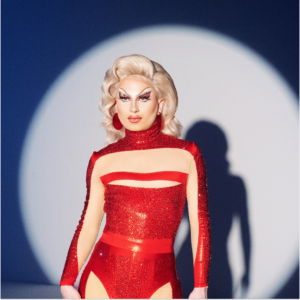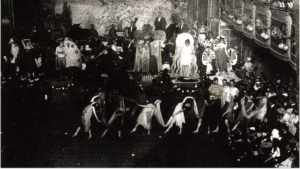17 year-old Cressida Anness Lorenz explains the origins of modern-day slang in queer subculture

Shady Lady, drag queen and musician. Promotional photoshoot for the clip "Ikona" from the latest album "Queer Pop", 2024.
June 27, 2024
How Gen Z adopted LGBTQ+ slang
You might have heard of ‘slay’, ‘tea’, ‘shade’ and ‘queen’… but do you know where they originate from?
Gen Z and millennials use these terms, in a variety of situations, from complimenting and hyping up their peers to expressing disrespect or disgust. But few seem to actually know where this slang came from.
Internet personality Adam Aleksic – known by his social media handle ‘etymologynerd’ – commented on this phenomenon in an Instagram video. He observed examples of this recent increase, with the words ‘serve’ and ‘slay’, commonly used as words of encouragement.
Aleksic, who specialises in linguistics, noted that this type of slang is first adopted by “straight white girls” and then mainstream society picks up what they are saying. He shared his prediction of the phrase “I’m gagged”, typically used to describe shock, rising in popularity after trending in gay and Black communities earlier this year.
These phrases first emerged in the mid to late 20th century from the queer community.
Speaking on the BBC Radio 4 programme Word of Mouth, Chloe O. Davis, lexicographer and author of The Queens’ English, explained that this underground language has been appropriated by mainstream culture, due to it being “so creative and useful and prevalent”. Davis notes how language lays the foundations of culture, describing the effect that slang can have for communities.
Many minority groups have their own approach to language, introducing their own slang terms that are recognised by those within their own communities. Examples of this include African-American Vernacular English (AAVE) used by Black Americans.
Both Aleksic and Davis credit the ballroom scene of New York from the 1960s to 1980s as the origin of these slang terms. The ballroom scene is a Latino and African American underground LGBTQ+ subculture in which people perform, lip-sync and model in different competitive categories.
Vancouver-based organisation Van Vogue Jam, a non-profit organisation dedicated to supporting its local ballroom scene, has explained how ballroom extended beyond extravagant events and entertainment.
Participants formed groups called ‘houses’, where older, more established members of the scene referred to as ‘mother’ and ‘father’ would look after and provide support for the ‘children’ of the house. Houses created a sense of community, helping queer people estranged from their families.
Due to the extremity of anti-LGBTQ+ laws and treatment of (particularly non-white) queer people, ballroom culture provided a safe space for people to express themselves in gender and sexuality non-conformity.
Aleksic highlights the ballroom scene of the late 1980s for the origin of terms such as ‘slay’, ‘serve’, ‘tea’ and ‘mother’, and describes the creation of these words as a “tool of power to build community”.
Fast-forwarding to the modern day, this slang has moved into the language pool of the general population, most likely using it without knowledge of its origins in queer subculture.
Jessica Rett of the LA Times believes that Gen Z slang has been “disproportionately sourced from Black and LGBTQ communities”.
Davis urged those who use this now-mainstream slang to give appropriate credit – “this is language that belongs to a community so we need to respect it and honour it” – so that the influences of LGBTQ+ culture in modern society can be properly celebrated and appreciated on a wider scale.





